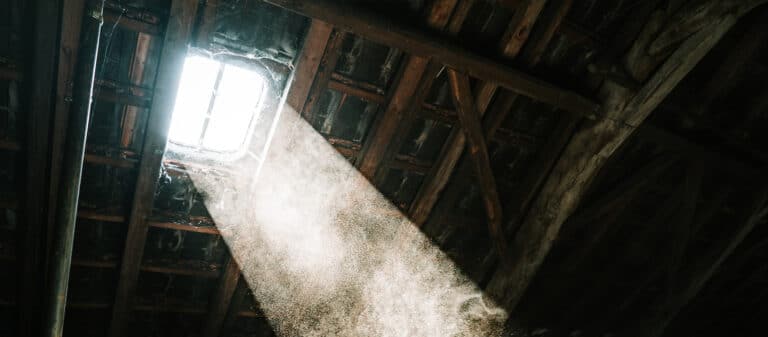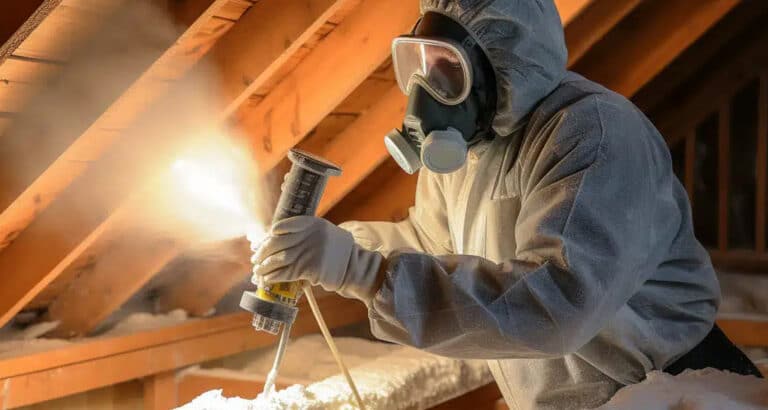According to a report by the Insulation Institute, 89% of single-family homes in the United States are underinsulated.
Part of the problem arises from the fact that it is more challenging to insulate an older home, whether it involves accessing behind-wall cavities or addressing poor ventilation in attic spaces.
Spray foam insulation can address many of the issues, allowing insulation to be inserted into tight spaces while also providing air sealing and moisture resistance.
Considered the top-of-the-line in terms of energy efficiency, spray foam insulation offers several advantages for homeowners in Northeast Pennsylvania, who must contend with bitterly cold winters and humid summers.
Whether you’re building a new home in Scranton or insulating an existing one in Wilkes-Barre, spray foam insulation is often an excellent choice.
To learn more about spray foam insulation and whether it’s right for your house, our experts will dive into the science behind spray foam insulation and the different types available.
What Is Spray Foam Insulation?
Spray foam insulation is a self-expanding foam made up of isocyanate and polyol resin.
This foam expands to fill wall cavities, ceilings, and floor joists, providing a thick layer of thermal insulation between surfaces while also sealing any cracks and gaps.
While you may see cans of spray foam at your local hardware store, spray foam insulation is specially formulated with a thicker mixture to provide thermal resistance against heat transfer and loss.
The Science Behind Spray Foam
The magic of spray foam begins with a chemical reaction. When the isocyanate and polyol resin are mixed at the spray nozzle, they undergo an exothermic reaction, releasing heat.
This causes the mixture to expand rapidly—sometimes up to 60 times its original volume—within seconds of application.
This reaction produces urethane foam, a lightweight, durable material that hardens into place. The foam’s expansion helps it reach into all the nooks and crannies where traditional insulation might not.
The spray foam mixture cures in minutes and provides excellent adhesive to building materials, so you don’t have to worry about settling.
Most importantly, when installed by a professional contractor, spray foam can provide even coverage without the need for cutting or trimming the material.
Open-Cell vs. Closed-Cell Foam: What’s the Difference?
Homeowners have two options when it comes to selecting the right spray foam mixture: open-cell and closed-cell foam. While closed-cell foam offers better performance, open-cell foam has its own advantages.
Open-Cell Spray Foam
Open-cell spray foam is lighter and less dense than its closed-cell counterpart, offering a cost-effective alternative. It has a spongy texture that allows water vapor to pass through, making it permeable to moisture. Open-cell can expand further to help reach difficult locations that even closed-cell spray foam may not hit.
Key Features
- R-value: ~R-3.5 to R-4 per inch
- Best Uses: Interior walls, soundproofing, and ceilings
- Pros: More affordable, excellent sound dampening, expands more for better air sealing
- Cons: Lower R-value per inch, not suitable for high-moisture areas
Closed-Cell Spray Foam
Closed-cell spray foam can rightly be considered the Cadillac of insulation. It’s much denser and more rigid than open-cell spray foam, offering a substantially higher R-value per inch of any insulation product on the market.
Each cell in the foam is completely closed and packed tightly together, providing a tight air seal and high thermal resistance.
- R-value: ~R-6 to R-7 per inch
- Best uses: Basements, crawl spaces, exterior walls, attics
- Pros: High R-value, acts as a vapor barrier, adds structural strength
- Cons: More expensive, requires professional installation
Benefits of Spray Foam Insulation
Whether you’re opting for open-cell or closed-cell spray foam, these insulation products offer several advantages over blown-in or batt insulation.
Air Sealing
One of the primary benefits of spray foam insulation is its ability to create an airtight barrier and block out leaks or holes in your ceilings or walls.
Unfortunately, traditional insulation methods, such as fiberglass or cellulose, can leave gaps where air can leak in or out and settle over time.
Spray foam is highly expandable, filling these holes in seconds, while the adhesive will help the mixture stick to building materials for a long time without the risk of settling.
In turn, air sealing and insulation can provide multiple benefits for homeowners:
- Reduces energy loss: Less heat escapes in the winter and enters in the summer.
- Improves indoor air quality: Keeps out allergens, pollutants, and moisture that can lead to mold.
In fact, the Department of Energy estimates that air leakage accounts for up to 40% of a home’s energy loss, making air-sealing solutions like spray foam critical in energy-efficient homes.
Moisture and Mold Control
Moisture intrusion can lead to wood rot, mold growth, and reduced insulation performance. Spray foam helps prevent this in several ways: Closed-cell spray foam acts as a vapor barrier, resisting the buildup of moisture inside your walls or ceilings.
Open-cell foam, while vapor-permeable, can still reduce moisture movement and may even be suitable for areas with poorer ventilation.
Additionally, spray foam’s air-sealing properties help maintain consistent indoor humidity levels, further reducing the likelihood of mold growth.
Enhancing Structural Integrity
Yes, the thermal resistance values of closed-cell spray foam are impressive, but did you know that it can also add tensile strength to building materials?
By some estimates, closed-cell spray foam can help add up to 15 to 25 psi of tensile strength to building materials, resisting sway from wind, physically adhering building materials together, and resisting moisture.
The benefits are even more pronounced inside weaker building metals, such as 22-guage corrugated metal or under.
Soundproofing Benefits
Thanks to its ability to fill even the tiniest gaps and cracks, open-cell and closed-cell spray foam are excellent for sound dampening.
Spray foam absorbs sound waves and reduces transmission through walls, ceilings, and floors, making it a favorite for media rooms, bedrooms, and multi-family dwellings.
Environmental and Energy Efficiency Impact
While spray foam is a petrochemical-based product, it can actually contribute to a lower overall environmental impact due to the energy savings it delivers over time. Over time, a well-insulated and air-sealed home will use less energy for heating and cooling and emit fewer greenhouse gases, resulting in a net reduction in its carbon footprint.
Professional Spray Foam Installation vs. DIY
Spray foam insulation may be the highest-rated insulation product, but that also means it’s the most expensive. To cut costs, some homeowners may be tempted to take on the job themselves.
However, unlike fiberglass batts, rolls, and rigid board, spray foam requires specialized machinery and proper application to ensure longevity.
Additionally, there are specific building codes that you will need to follow, particularly regarding vapor barriers and ventilation. Installing spray foam incorrectly can cause significant damage to your home, which is why we recommend leaving it to the professionals.
Is Spray Foam Right for Me?
Spray foam isn’t a one-size-fits-all solution. While it offers unparalleled performance in many applications, it may not be necessary or cost-effective for all homes. Factors that homeowners should consider include:
- Climate zone: Colder areas may benefit more from higher R-values. Resting in climate zone 5, spray foam is a great product for Pennsylvania homes.
- Home age and design: Older homes can benefit from spray foam and its air-sealing qualities. However, additional ventilation may be required.
- Budget: Spray foam costs more upfront, but tends to pay for itself better than any other product in the long run.
- Moisture risks: Proper evaluation is needed to ensure moisture control. While closed-cell spray foam acts as a natural vapor barrier, it can also increase moisture if installed incorrectly.
- Existing insulation: Spray foam can often be added to existing insulation, including rigid board and fiberglass. However, a proper assessment is recommended.
A home energy audit or consultation with an insulation contractor can help you determine the best strategy for your specific needs.
For more information about installing spray foam insulation in Northeast Pennsylvania, contact the insulation pros at NEPA EnergySmart for a free quote.
FAQs
Is spray foam insulation safe for indoor use?
Yes, when installed correctly by professionals, spray foam insulation is safe. It releases gases during curing, so occupants should avoid the area for 24–48 hours after installation. Once cured, it is inert and safe for indoor environments.
How long does spray foam insulation last?
Spray foam insulation can last 80+ years with proper installation. It doesn’t sag or settle over time like some other types of insulation, which helps maintain its energy-saving performance for decades.
Can spray foam insulation be installed in existing homes?
Yes, spray foam can be retrofitted into existing homes, especially in attics, basements, crawl spaces, and wall cavities (via injection methods). A professional evaluation can determine the best approach for your home.











